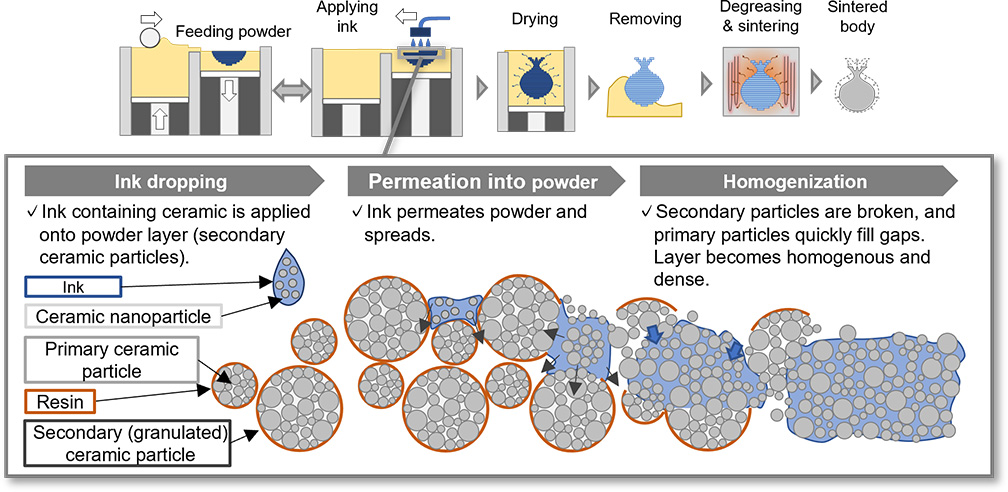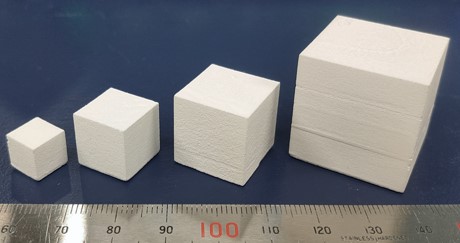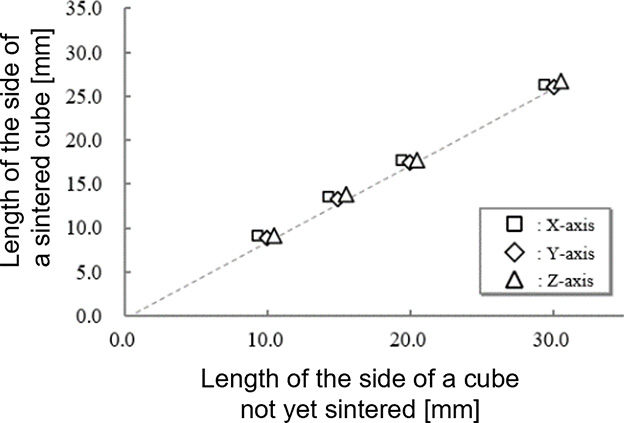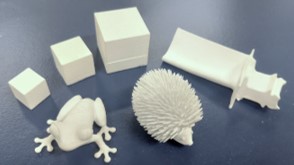- Home
- Ricoh's Technology
- Innovative Ceramic 3D Printer
Innovative Ceramic 3D Printer
Background
Heat engines, including power generators, automobiles, and aircraft, must always have high energy efficiency. As ceramic material is lighter than metal and is resistant to heat and acid, expectations are high for using ceramic components and jigs in energy and mobility, particularly for use in power generators.

Solutions
Ceramics cannot be melted and molded as they have a high melting point and are not easily machinable. So in existing processing methods for ceramic parts, there is a tradeoff between size, thickness, and shape complexity. The same applies to existing 3D printers for ceramic materials.
Ricoh is developing a novel 3D modeling technology called particle homogenizing modeling to overcome these challenges. Working with materials and processes, the development team is determining how ceramic objects can be manufactured, in the shortest time possible, to have the forms and strength required for structural components.
Technical highlights
Ceramic components with excellent modeling quality can be produced.
Particle homogenizing modeling technology
Primary ceramic particles (small particles) are bonded with a small amount of resin to form secondary particles (granulated particles), which are spread with a roller. Ink that contains ceramic nanoparticles is applied onto the target areas of the secondary particle layer. The ink breaks the secondary particles as it spreads, and the nanoparticles enter the gaps between the primary particles. Thus, the ceramic nanoparticles are closely bonded together, homogenously, throughout the layer. This structure allows the layer to be sintered efficiently. This process is repeated until the object is formed in the powder; the liquid elements of the ink are then dried off to leave a green body*. The green body is taken out from the powder and baked to evaporate the internal resin elements. The object is thus sintered to have a high density. This technology will resolve the tradeoff between shape complexity, material strength, production time, and production costs, which is often encountered with conventional processes.
- *
- Green body: Shaped powder material that has not yet been baked
 3D modeling technology being developed by Ricoh
3D modeling technology being developed by Ricoh
Excellent modeling quality
Ricoh's new approach shapes objects with less resin than existing processes, thus preventing thick parts from being cracked or deformed during thermal processing. The nanoparticles facilitate densification during the sintering process, maximizing ceramic purity and allowing the inherent qualities of the materials to be exhibited.
 3D printed and sintered cube
3D printed and sintered cube

Exploiting our expertise in printer and toner development, Ricoh will combine inkjet technology with powder processing technology to create unprecedented functionality. The new process will be applied to alumina (aluminum oxide) and any materials that require sintering, including silicon carbide (SiC) and other ceramics.
Ricoh's vision
Ricoh believes that greater use of ceramics can contribute to various fields. For instance, using ceramics means parts exposed to high heat or in corrosive environments may be lightweight and have improved system efficiency. Ricoh will achieve functions and quality not possible in the past by controlling homogenization, an extremely complex phenomenon triggered by a reaction between the granulated particles and the nanoparticle-containing ink.
 3D printed alumina parts
3D printed alumina parts
Sorted by : field “Inkjet” “Resource Conservation” “Materials”